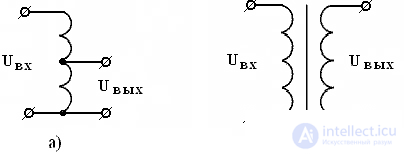Lecture
A transformer is a static electromagnetic device that converts the parameters of electrical energy of alternating current (voltage, current, form, number of phases, etc.). A transformer is a magnetic circuit with one or several windings applied to it [1].
Depending on the purpose, transformers are divided into power, matching and pulse.
According to the circuit design, there are single-winding or autotransformers and multiwinding (figure 1).

Figure 1 - Autotransformer (a) and multiwinding transformer (b)
By design, transformers are distinguished: armor, rod, toroidal, three-phase, ring and cable. All of them differ in cooling conditions and inductance of dispersion. The location of the windings on the magnetic cores (cores) in black is shown in Figure 2.

Figure 2. - The design of transformers
The part of the magnetic circuit, on which the winding is applied, is called a rod, and the open part is called a yoke. The toroidal transformer has the smallest leakage inductance (the entire magnetic circuit is covered by windings!), And the cable transformer has the greatest one. The worst conditions for cooling the core also have a toroidal transformer, since losses (heat) from the core have nowhere to go. The most famous and common first three designs. Their location in ascending order of inductance of scattering: c, b, a. The arrangement in order to improve the cooling conditions of the core is the same: c, b, a. It is the problem of heat removal that led to the appearance of transformers with air radiators, with water and with oil cooling, but these are already special types of transformers.
Comments
To leave a comment
Power supplies for electronic equipment
Terms: Power supplies for electronic equipment